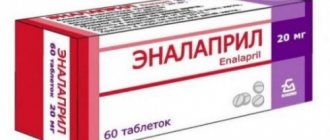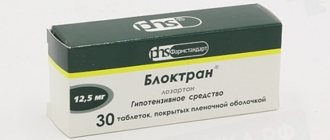Lorista
Lorista (active ingredient - losartan) is an antihypertensive drug, an angiotensin II receptor blocker with selective action (it exhibits antagonism exclusively to AT1 type receptors). Medicines for the treatment of cardiovascular diseases are today, perhaps, the most popular part of the pharmacy assortment, occupying the largest area on display windows. This is not surprising: cardiovascular pathology is currently firmly entrenched in the sole leading position in the structure of overall mortality, exceeding similar indicators from all other possible causes combined. The antihypertensive effect of Lorista is based on the ability of the drug to erect an insurmountable barrier between AT1 receptors and angiotensin II, thereby blocking all physiologically significant effects of the latter, regardless of the route of its formation in the body. Thus, angiotensin II cannot realize its remarkable vasopressor potential, although its amount does not decrease, as occurs with treatment with angiotensin-converting enzyme inhibitors. It is important that, unlike the latter, Lorista does not inhibit the enzyme kininase II, which is involved in the metabolism of bradykinin. As a result, there is no accumulation of excess bradykinin, which avoids the associated side effects of cough and angioedema. Lorista reduces total peripheral vascular resistance, pressure in the pulmonary circulation, reduces afterload on the myocardium, and has a moderate diuretic effect. The drug prevents the development and progression of left ventricular hypertrophy (a predictor of cardiovascular events) and increases resistance to physical exercise in patients suffering from chronic heart failure. In order to achieve a clinically significant reduction in systolic (upper) and diastolic (lower) blood pressure, it is enough to take Lorista once a day. The drug maintains blood pressure at a given level throughout the day, without sudden changes and in accordance with the natural circadian rhythm.
The decrease in blood pressure at the end of a single dose of Lorista is about 70-80% of the antihypertensive effect 5-6 hours after administration, when the peak effect of the drug is noted. The drug does not cause a reflex increase in heart rate and a rebound increase in blood pressure after cessation of pharmacotherapy. Lorista is effective in patients regardless of their gender and age. One of the main studies demonstrating the effectiveness of the drug in arterial hypertension was the multicenter randomized LIFE trial. It involved more than 9 thousand patients who, in addition to persistently elevated blood pressure, also had left ventricular hypertrophy. Study participants were divided into two groups taking losartan (Lorista) and atenolol, respectively. When analyzing the study results, it was found that mortality in the losartan group was almost two times lower than in the atenolol group. Patients in the losaratan group were less likely to develop cardiovascular events such as ischemic stroke and acute myocardial infarction. The dynamics of the decrease in blood pressure were comparable in both groups, while in the losaratan group, patients experienced a much more pronounced regression of left ventricular hypertrophy. Thus, Lorista has proven to be a more promising drug in the treatment of arterial hypertension than atenolol. In general, Lorista, as well as all sartans (as the group of angiotensin II receptor blockers is more compactly called), is better tolerated than other groups of antihypertensive drugs. If we talk exclusively about losartan (lorist), then this drug has the most solid evidence base among all sartans, being the most studied representative of this group of drugs and having the largest number of indications for use.
Lorista, 30 pcs., 12.5 mg, film-coated tablets
More than 20,000 patients took part in studies on the effectiveness and safety of Lorista.
The results of the studies demonstrated the following data:
— in the “Take Off” study, Lorista® (losartan from KRKA) significantly reduced uric acid levels by 32.6% in patients with arterial hypertension (AH) and concomitant hyperuricemia and/or gout. 100% of patients participating in the study achieved the target blood pressure level. Therapy with Lorista has a pronounced positive effect on the elasticity of the vascular wall in patients with hypertension1;
— in the open-label multicenter clinical trial LAURA2 (Lorista® and uric acid), the relationship between treatment with Lorista and its fixed combination with hydrochlorothiazide (Lorista® H and Lorista® HD) and hyperuricemia was studied. Based on the results of the study in patients with hypertension and hyperuricemia, Lorista®, Lorista® H and Lorista® ND, due to their apparent ability to lower uric acid levels, can be used as the preferred therapy;
— the EFFECT3 study proved the effectiveness and safety of losartan (Lorista®) in patients with mild and moderate hypertension. In addition, it is important to emphasize the safety of using Lorista (adverse effects in less than 1% of patients), which makes the drug an indispensable assistant in the fight against hypertension;
— as a result of the international study Gemera4, the effectiveness and safety of the use of Lorista® and a fixed combination with hydrochlorothiazide (Lorista® N) in patients with stage 1–2 hypertension was confirmed. 100% of patients achieved CAP.
The results of clinical studies conducted with the drug KRKA Lorista (losartan) and its fixed combinations with hydrochlorothiazide further indicate that the drug contributes not only to the effective and well-tolerated treatment of hypertension, but also to the reduction of cardiovascular risk.
Literature
1. Nedogoda S.V., Ledyaeva A.A., Chumachok E.V., Tsoma V.V., Salasyuk A.S. Possibilities of losartan in angioprotection against hyperuricemia in patients with arterial hypertension. Systemic hypertension. - 2012. - No. 4. - P.50–54.
2. Svishchenko E.P., Bezrodnaya L.V., Gorbas I.M. Clinical and uricosuric efficacy of losartan in patients with arterial hypertension. Results of the open multicenter clinical trial LAURA. Arterial hypertension.- 2012.- 5 (25).- P.25–32.
3. Drapkina O.M., Kozlova E.V. The place of angiotensin receptor antagonists in the treatment of cardiovascular diseases. Study EFFECT: use of Lorista in patients with mild and moderate arterial hypertension in real clinical practice. Problems of women's health.- 2009.- 4(4).- P.17–26.
4. Chazova I.E., Martynyuk T.V. Federal State Budgetary Institution Russian Cardiology Research and Production Complex of the Ministry of Health of the Russian Federation, Moscow. First results of the international clinical trial GEMERA: two therapeutic regimens for the effective treatment of patients with stage 1–2 arterial hypertension.
Instructions for use of LORISTA®
Angiotensin II type AT1 receptor antagonist for oral administration. Angiotensin II, a powerful vasoconstrictor, is the primary active hormone of the RAAS and an important determinant of the pathophysiology of hypertension. Angiotensin II binds to AT1 receptors found in many organs and tissues of the body (for example, vascular smooth muscle, adrenal glands, kidneys and heart) and causes several important biological effects, including vasoconstriction and the release of aldosterone. Angiotensin II also stimulates the proliferation of smooth muscle cells.
Losartan selectively blocks AT1 receptors. In vitro and in vivo, losartan and its pharmacologically active carboxylic acid metabolite E-3174 block all physiologically significant actions of angiotensin II, regardless of the source or route of synthesis.
Losartan does not have an agonistic effect and does not block other hormone receptors or ion channels important for cardiovascular regulation. In addition, losartan does not suppress ACE (kininase II), an enzyme that destroys bradykinin. As a consequence, there is no potentiation of undesirable effects mediated by bradykinin.
When taking losartan, removal of the negative feedback of angiotensin II on renin secretion leads to an increase in plasma renin activity (PRA). An increase in ARP leads to an increase in the concentration of angiotensin II in plasma. Despite this, antihypertensive activity and suppression of plasma aldosterone concentrations are maintained, indicating effective blockade of angiotensin II receptors. After discontinuation of losartan, the values of ARP and angiotensin II fell within 3 days to baseline values.
Both losartan and its main active metabolite have a much greater affinity for the AT1 receptor than for the AT2 receptor. The active metabolite is 10-40 times more active than losartan.
Hypertension Research
In controlled clinical studies, taking losartan once a day in patients with mild or moderate essential hypertension provided a statistically significant reduction in systolic and diastolic blood pressure. The results of blood pressure measurements 24 hours after dosing relative to the results of measurements 5-6 hours after dosing showed a decrease in blood pressure within 24 hours; the natural circadian rhythm was maintained. The decrease in blood pressure at the end of the dosing interval accounted for 73-80% of the effect observed 5-6 hours after taking the drug dose.
Discontinuation of losartan in patients with hypertension did not lead to a sharp increase in blood pressure (rebound phenomenon). Despite the pronounced decrease in blood pressure, losartan did not have clinically significant effects on heart rate.
Losartan is equally effective in men and women, as well as in older and younger (under 65 years of age) patients with arterial hypertension.
LIFE Study
The LIFE (Losartan Intervention For Endpoint Reduction in Hypertension) study was a randomized, triple-blind, active-controlled trial involving 9193 patients aged 55 to 80 years with hypertension and evidence of left ventricular hypertrophy confirmed by ECG. Patients were randomized to receive losartan 50 mg once daily or atenolol 50 mg once daily. If target blood pressure (<140/90 mmHg) was not achieved, hydrochlorothiazide (12.5 mg) was first added to therapy, and then, if required, the dose of losartan or atenolol was increased to 100 mg once a day. Other antihypertensive drugs, excluding ACE inhibitors, angiotensin II antagonists, or beta-blockers, were added as needed until target BP was achieved. The mean follow-up duration was 4.8 years.
The primary endpoint was a composite endpoint of cardiovascular disease and death due to cardiovascular disease, measuring reductions in the cumulative incidence of cardiovascular death, stroke, and myocardial infarction. BP was significantly reduced to similar levels in the two groups. Losartan therapy resulted in a 13% risk reduction (p=0.021, 95% confidence interval 0.77–0.98) compared with atenolol therapy for patients achieving the composite primary endpoint. This was mainly due to a reduction in the incidence of stroke. Therapy with losartan resulted in a 25% reduction in the risk of stroke compared with therapy with atenolol (p=0.001, 95% confidence interval 0.63-0.89). There were no significant differences in the incidence of cardiovascular death and myocardial infarction between treatment groups.
In the LIFE study, black patients receiving losartan were at greater risk of achieving the composite primary endpoint, i.e. cardiovascular event (eg, myocardial infarction, cardiovascular death) and especially stroke than black patients receiving atenolol. Therefore, the results obtained with losartan versus atenolol in the LIEE study on cardiovascular morbidity and mortality do not apply to black patients with hypertension and left ventricular hypertrophy.
RENAAL Study
The RENAAL (Reduction of Endpoints in NIDDM with the Angiotensin II Receptor Antagonist Losartan) study was a controlled clinical trial conducted worldwide in 1513 patients with type 2 diabetes mellitus with proteinuria, with or without hypertension. 751 patients received losartan.
The aim of the study was to demonstrate the nephroprotective effect of losartan potassium in addition to the hypotensive effect. Patients with proteinuria and serum creatinine 1.3-3 mg/dL were randomized to receive losartan 50 mg once a day (with dose titration, if necessary, to achieve target blood pressure) or placebo, against the background of traditional antihypertensive therapy, for with the exception of ACE inhibitors and angiotensin II receptor antagonists.
The study drug was titrated to a dose of 100 mg/day, if necessary; 72% of patients took the drug at a dose of 100 mg/day most of the time. As adjuvant therapy, if necessary, the use of other antihypertensive drugs (diuretics, calcium antagonists, α- and β-adrenergic receptor blockers, as well as centrally acting antihypertensive drugs) was allowed in both groups. Patients were followed up to 4.6 years (average 3.4 years).
The primary endpoint of the study was a composite endpoint that included a 2-fold increase in serum creatinine concentration, end-stage renal failure (requirement for dialysis or transplant), or death. Results showed that losartan therapy (327 events) compared with placebo (359 events) resulted in a 16.1% (p=0.022) risk reduction in the number of patients achieving the primary composite endpoint. For the following individual and composite components of the primary endpoint, results showed a significant risk reduction in the losartan group; risk reduction by 25.3% for a 2-fold increase in serum creatinine concentration (p=0.006); 28.6% risk reduction for end-stage renal disease (p=0.002); 19.9% risk reduction for end-stage renal disease or death (p=0.009); a 21% risk reduction for a 2-fold increase in serum creatinine concentration or for end-stage renal disease (p=0.01). There were no significant differences in the incidence of deaths from any cause between the two treatment groups.
In this study, losartan was generally well tolerated:
- the rate of treatment discontinuation due to adverse events was comparable to the rate in the placebo group.
HEAAL Study
The HEAAL (Heart Failure Endpoint Evaluation of Angiotensin II Antagonist Losartan) study was a controlled, worldwide clinical trial of 3834 patients aged 18 to 98 years with heart failure (NYHA class II-IV) who were intolerant to therapy. ACE inhibitors. Patients were randomized to groups receiving losartan at a dose of 50 mg/day or 150 mg/day, against the background of traditional therapy (except for ACE inhibitors).
Patients were followed up for 4 years (median 4.7 years). The primary endpoint of the study was a composite endpoint of death from any cause or hospitalization for heart failure.
The results showed that therapy with losartan 150 mg (828 events), compared with therapy with losartan 50 mg (889 events), resulted in a 10.1% reduction in risk (p=0.027 95% confidence interval 0.82-0.99) in the number of patients achieving the primary composite endpoint. This was mainly due to a reduction in the frequency of hospitalizations for heart failure. Therapy with losartan 150 mg resulted in a 13.5% reduction in the risk of hospitalization for heart failure compared with therapy with losartan 50 mg (p=0.025 95% confidence interval 0.76-0.98). There were no significant differences in the incidence of death from any cause between treatment groups. Renal impairment, hypotension, and hyperkalemia were more common in the 150 mg losartan group than in the 50 mg losartan group, but these adverse events did not lead to significantly more discontinuations in the losaratan group. at a dose of 150 mg.
ELITE I and ELITE II Study
In the 48-week ELITE study in 722 patients with heart failure (NYHA class II-IV), there was no difference between patients treated with losartan and patients treated with captopril in the primary endpoint of long-term change in kidney function. The conclusion of the ELITE study that losartan reduced the risk of death compared with captopril was not confirmed in the subsequent ELITE II study, which is described below.
In the ELITE II study, losartan 50 mg once daily (initial dose 12.5 mg, increased to 25 mg, then 50 mg once daily) was compared with captopril 50 mg 3 times daily (initial dose 12.5 mg, increased to 50 mg once daily). increasing to 25 mg, then 50 mg 3 times a day). The primary endpoint of this prospective study was death from any cause.
In this study, 3152 patients with heart failure (NYHA class II-IV) were followed for almost 2 years (median:
- 1.5 years) to determine whether losartan is superior to captopril in reducing all-cause mortality. The primary endpoint showed no statistically significant difference between losartan and captopril in the reduction of mortality from any cause.
In both comparator-controlled (rather than placebo-controlled) clinical studies, losartan was shown to be tolerable to captopril based on significantly lower rates of discontinuation due to adverse events and significantly lower rates of cough.
Increased mortality was observed in the ELITE II study in a small subgroup (22% of all patients with heart failure) taking beta blockers at baseline.
Two large randomized controlled trials (ONTARGET (Telmisartan Alone and in combination with Ramipril Global Endpoint Trial) and VA NEPHRON-D (The Veterans Affairs Nephropathy in Diabetes)) examined the use of ACE inhibitors in combination with angiotensin II receptor antagonists.
The ONTARGET study was conducted in patients with cardiovascular disease, cerebrovascular disease or type 2 diabetes with evidence of end-organ damage. The VA NEPHRON-D study was conducted in patients suffering from type 2 diabetes mellitus and diabetic nephropathy.
These studies did not show a significant beneficial effect (compared with monotherapy) on renal function and/or cardiovascular outcome and mortality, while an increased risk of hyperkalemia, acute renal failure and/or hypotension was observed. Due to similar pharmacodynamic properties, these results apply to other ACE inhibitors and angiotensin II receptor antagonists. Therefore, ACE inhibitors and angiotensin II receptor antagonists should not be used simultaneously in patients with diabetic nephropathy.
The ALTITUDE (Aliskiren Trial in Type 2 Diabetes Using Cardiovascular and Renal Disease Endpoints) study was designed to determine the benefit of adding aliskiren to standard ACE inhibitor or angiotensin II receptor antagonist therapy in patients with type 2 diabetes mellitus, chronic renal failure, and cardiovascular disease. The study was stopped early due to an increased risk of adverse outcomes. Stroke and cardiovascular mortality were observed more often in the aliskiren group than in the placebo group. Also, in the group taking aliskiren, undesirable side effects (hyperkalemia, hypotension, renal dysfunction) were more often observed.


